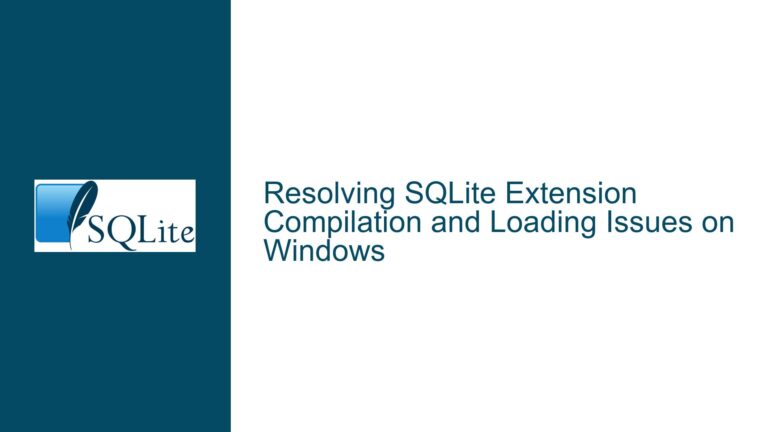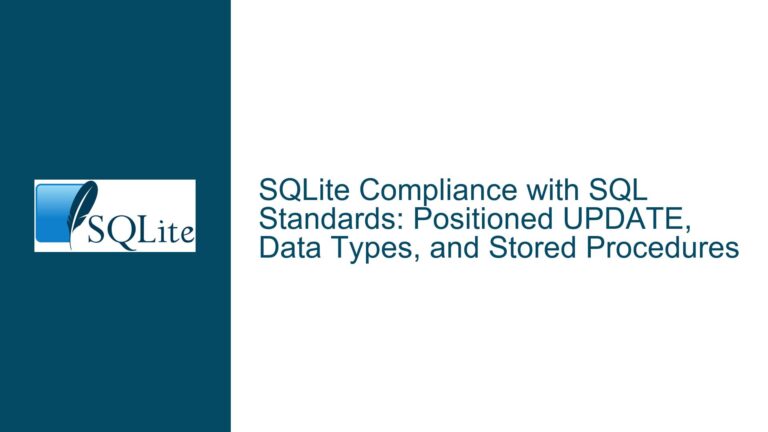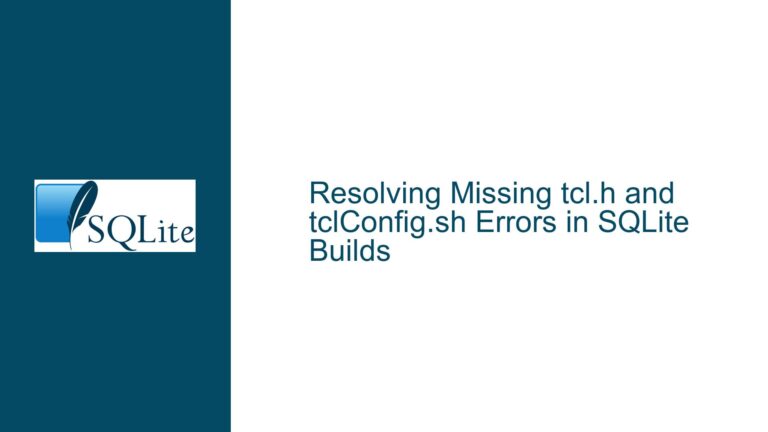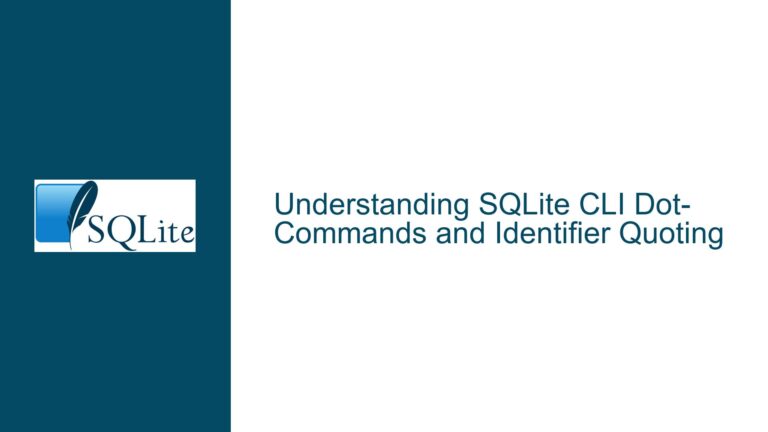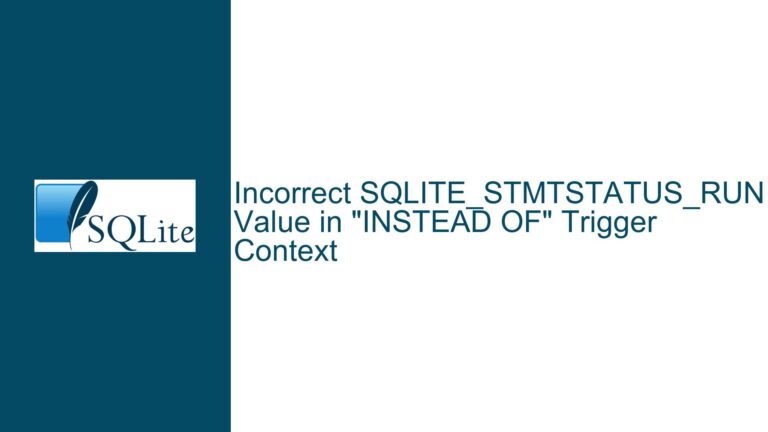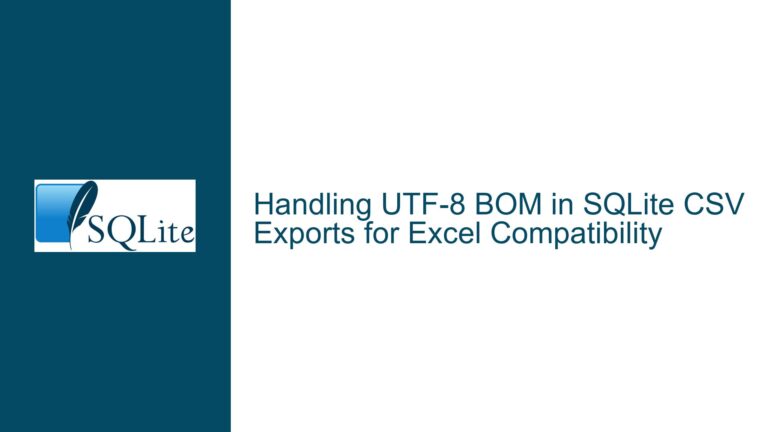SQLite Extensible Shell: Tk Integration and Event Loop Challenges
Tk Integration and Event Loop Processing in SQLite Extensible Shell
The SQLite Extensible Shell, or sqlite3x, introduces a powerful set of features that extend the capabilities of the traditional SQLite shell. One of the most anticipated features is the integration of Tcl scripting, including support for Tk, the graphical user interface toolkit for Tcl. However, this integration has encountered significant challenges, particularly around event loop processing and console line-editing compatibility. This post delves into the core issues, their underlying causes, and potential solutions for achieving seamless Tk integration within the SQLite Extensible Shell.
Challenges with Tk Integration and Event Loop Processing
The primary issue with Tk integration in the SQLite Extensible Shell stems from the fundamental incompatibility between Tcl’s event-driven architecture and the traditional console input model used by the shell. Tcl, and by extension Tk, relies on an event loop to handle graphical user interface (GUI) events, such as button clicks, window resizing, and other interactive actions. This event loop must run periodically to process these events, which is at odds with the blocking nature of console input in the SQLite shell.
In the traditional SQLite shell, console input follows a "blocking" model: the shell waits for the user to input a complete line of text before proceeding. This model works well for command-line interfaces but creates a conflict when Tk is introduced. Tk requires the event loop to run continuously to process GUI events, but the blocking input model prevents this from happening. As a result, Tk windows fail to render correctly, and interactive elements like buttons and menus do not respond to user input.
This issue is exacerbated when line-editing libraries are used in conjunction with the shell. These libraries, which provide features like command history and tab completion, also rely on blocking input mechanisms. The combination of Tk’s event loop and line-editing libraries creates a complex interaction that is difficult to reconcile without significant architectural changes.
Root Causes of the Event Loop Conflict
The root cause of the event loop conflict lies in the design philosophies of the two systems: Tcl/Tk and the SQLite shell. Tcl/Tk is inherently event-driven, meaning it expects to periodically process events from the operating system or user interactions. This is essential for rendering GUI elements and responding to user actions in real time. On the other hand, the SQLite shell is designed as a command-line tool, where input is processed line-by-line, and the shell blocks execution until a complete line is received.
The incompatibility arises because the SQLite shell’s blocking input model prevents the Tcl event loop from running. When the shell is waiting for user input, the event loop is effectively paused, causing Tk windows to freeze and become unresponsive. This issue is particularly pronounced when line-editing libraries are used, as they introduce additional layers of input handling that further interfere with the event loop.
Another contributing factor is the lack of a unified mechanism for integrating event-driven and blocking input models. While Tcl provides ways to integrate with external event loops, these mechanisms are not natively supported by the SQLite shell. As a result, developers must implement custom solutions to bridge the gap between the two systems, which can introduce complexity and potential instability.
Solutions and Workarounds for Tk Integration
Addressing the challenges of Tk integration in the SQLite Extensible Shell requires a multi-faceted approach that balances the needs of both event-driven and blocking input models. Below are several potential solutions and workarounds, ranging from architectural changes to practical compromises.
1. Implementing a Replaceable Console I/O Subsystem
One promising solution is to modularize the console I/O subsystem, allowing it to be replaced or extended to support event-driven input. This approach involves creating a separate component responsible for handling console input and output, which can be swapped out depending on the use case. For example, a traditional blocking I/O subsystem could be used for command-line interactions, while an event-driven subsystem could be used when Tk is active.
This modular design would enable the SQLite Extensible Shell to support both models without compromising functionality. The event-driven subsystem could periodically run the Tcl event loop while still allowing for user input, ensuring that Tk windows remain responsive. This approach would also make it easier to integrate line-editing libraries, as they could be adapted to work with the event-driven subsystem.
2. Leveraging Asynchronous Input Mechanisms
Another potential solution is to use asynchronous input mechanisms, such as non-blocking I/O or multithreading, to allow the event loop to run concurrently with console input. This would involve modifying the SQLite shell to periodically check for input without blocking execution, enabling the Tcl event loop to process GUI events in the background.
While this approach is technically feasible, it introduces additional complexity and potential performance overhead. Careful implementation would be required to ensure that input handling remains reliable and that the shell’s performance is not adversely affected. Additionally, this solution may require significant changes to the shell’s architecture, making it a longer-term goal rather than an immediate fix.
3. Providing a Tk-Specific Mode
A more pragmatic solution is to introduce a Tk-specific mode in the SQLite Extensible Shell, where the shell temporarily switches to an event-driven input model when Tk is active. This mode would disable traditional line-editing features and use a simplified input mechanism that allows the event loop to run. While this approach would limit functionality when Tk is in use, it would provide a practical workaround for users who need Tk support.
This solution could be implemented as an optional feature, allowing users to enable or disable Tk mode as needed. It would also provide a clear separation between command-line and GUI interactions, reducing the risk of conflicts between the two models.
4. Developing Custom Event Loop Integration
For advanced users and developers, another option is to develop custom event loop integration that bridges the gap between Tcl’s event loop and the SQLite shell’s input model. This could involve writing custom Tcl scripts or C code to periodically run the event loop while still allowing for console input. While this approach requires significant expertise, it offers the most flexibility and control over the integration process.
Custom event loop integration could also be used to address specific use cases, such as embedding the SQLite Extensible Shell in other applications. By providing hooks for custom event loop handling, the shell could be adapted to work in a variety of environments without requiring changes to its core architecture.
Conclusion
The integration of Tk in the SQLite Extensible Shell presents a unique set of challenges, primarily due to the incompatibility between Tcl’s event-driven architecture and the shell’s blocking input model. While these challenges are significant, they are not insurmountable. By implementing a modular console I/O subsystem, leveraging asynchronous input mechanisms, providing a Tk-specific mode, or developing custom event loop integration, it is possible to achieve seamless Tk integration without compromising the shell’s functionality.
As the SQLite Extensible Shell continues to evolve, addressing these challenges will be critical to unlocking its full potential as a versatile and powerful tool for both command-line and graphical user interface interactions. With careful planning and innovative solutions, the shell can provide a robust platform for developers and users alike, enabling new possibilities for data management and application development.

